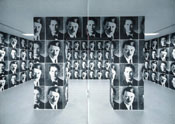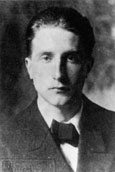An Open Letter to Donald Kuspit
from Elliott Barowitz
All quotations in the following letter were taken from a taped recording of the "Jewish Holocaust in Art" session (24 February 2000; 9:30 AM - Noon) at the 88th Annual Conference of the College Art Association held at the Hilton Hotel in New York City, 23 - 26 February 2000. The recording was made by the CAA.
Dear Donald:
In regard to an exchange of words we had at the College Art Association Conference 2000 during the panel "Jewish Holocaust in Art" (February 24, 2000), I would like to add the following.
|
Click
to enlarge
|
|
Rudolf
Herz, Zugzwang, 1995 (Room installation at the Kunstverein
Ruhr e.V., Essen, Germany)
© photo: Werner J. Hannappel |
I was puzzled about the work and asked for clarification. In my short discourse I said I thought that the juxtaposition of Duchamp with Hitler was bizarre, and I suggested (tongue in cheek) that it might have been appropriate to also include a photograph of Lee Miller since Man Ray (who had become the (un)official photographer of Duchamp) also photographed Miller. Plus, Lee Miller, who reportedly bathed in Hitler's tub, was one of the subjects of a presentation by Carol Zemel of the State University of New York, Buffalo. In her discussion of the so-called liberation photographs by Margaret Bourke-White and Miller, Zemel suggested that the two women's photographs tended to "anesthetize and aestheticize" the Holocaust. I could not agree more and I indeed feel that Herz's Zugzwang "anesthetizes and aestheticizes" Hitler.
Kleeblatt was confused by my question — indeed he had a right to be — but you, Donald, asked for the microphone and said, "I don't think it's so bizarre at all. Duchamp was a terrorist, wasn't he? [Microphone disturbances] I just wanted to say that I don't think it's so bizarre at all. Duchamp was a terrorist and so was Hitler, and Duchamp was a fetish object, as Hitler is. And a lot of art historians, there are a whole group of art historians who click their intellectual heels and make the Duchamp salute these days. They are both fairly disruptive figures. I think Duchamp was an extremely disruptive influence on art, despite the rationalization of it as, quote, conceptual and so forth. So I think it is a wonderful and actually rather insightful connection to put Hitler and Duchamp together."
|
Click
to enlarge
|
|
Photograph
of Marcel Duchamp by Hans Hoffmann, Munich, 1912
|
At this point I said, "The fact that Duchamp skipped out of France in World War I might make him a draft-dodger or a coward … but to call … a coward a terrorist is ridiculous." Your response was: "Cowards can be terrorists — the art world is a place were artists can be terrorists." This drew some laughter from the audience as I protested and gestured trying to show you that there was no proportion to your statement.
The discussion moved on to other statements and questions but toward the end of the session you took hold of the microphone again and said, "Incidentally, I'd like to say one last thing to defend myself about what looks like mockery — artists as cowards — you know, the art world as cowards. There is a famous incident … there was a Dadaist happening in Germany and … I believe there was one of the events where one of the Dadaists went and took all the money and invited people to a lecture and didn't give the lecture — took the money and made some mockery. They were brought into court — this is documented, okay. They were brought into court — some famous Dadaist, and they were trembling, trembling — brought into court and the judge said to them, ‘How do you explain the fact that you stole all the people's money?' Then he looked at them trembling and said, ‘Oh, you're artists, you were artists. Oh, okay. Case dismissed.'"
If the case existed (neither I nor those I've consulted have found any evidence of it), its German judge was the Weimar equivalent of the New York Supreme Court Judge "turn ‘em loose Bruce" Wright of the 1970s. And who was the "famous" Dada artist or artists? The Jew Tristan Tzara, the Communist George Grosz or the diminutive Helmut Herzfelde, a.k.a. John Heartfield — who in utter disgust for the Kaiser's militarism anglicized his name after WWI and who depicted the Nazis, Hitler, Göhring, et al, in unflattering situations? Cowards, you say. Yes, I suppose in the end they were cowards because they did choose to flee (an instinct we share with other species when they or we feel threatened).
I suppose that cowards can be terrorists, but we more often associate terrorists with martyrs. Can one call Hitler a terrorist? I believe that one can call Hitler any bad name possible. I prefer mass-genocidal murderer, myself. Does Duchamp fit those descriptions? No!
As for the "fetish object" association you assigned to both Duchamp and Hitler, were you referring to Rrose Sélavy of the Man Ray photographs or Duchamp portraying the fig-leafed Adam on stage, his playing chess with a nude woman, or smoking a cigar? Dare I say that skinheads surround themselves with Nazi images, and not with those of Duchamp? Were you being cynical when you said that "they are both fairly disruptive figures"? But lastly, I can't help but put together rather horrible images and thoughts about Nazis when in two short sentences you use "fetish," "clicking … heels" and "salute" to describe Duchampian art historians. Who would that include? Arturo Schwarz? Francis Naumann? Rosalind Krauss? Calvin Tomkins? Rhonda Shearer? Arthur Danto? Who? Wha?
Sincerely,
Elliott Barowitz
| |
|
|
|
|
|
|
|
|
onMouseOver="document.images['Link10'].src='../images/Bar1_03_09_over.gif';"
onMouseOut="document.images['Link10'].src='../images/Bar1_03_09.gif';">
 |

